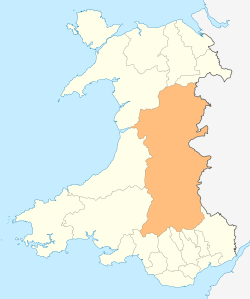Llanfechain
| Llanfechain | |
|---|---|
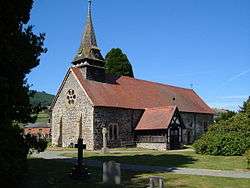 St Garmon's Church, Llanfechain | |
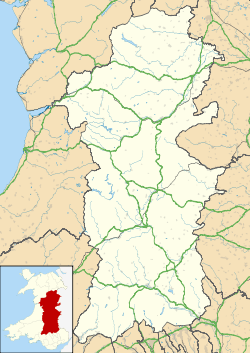 Llanfechain Llanfechain shown within Powys | |
| Population | 465 (2011)[1] |
| OS grid reference | SJ190203 |
| Community |
|
| Principal area | |
| Ceremonial county | |
| Country | Wales |
| Sovereign state | United Kingdom |
| Post town | LLANFECHAIN |
| Postcode district | SY22 |
| Dialling code | 01691 |
| Police | Dyfed-Powys |
| Fire | Mid and West Wales |
| Ambulance | Welsh |
| EU Parliament | Wales |
| UK Parliament | |
| Welsh Assembly | |
Llanfechain is a small village and community in Powys, Wales, between Llanfyllin and Llansantffraid-ym-Mechain on the B4393 road. Historically it was part of Montgomeryshire. Afon Cain runs through the village. It has a population of less than 500.
Name
Llanfechain could mean "parish or church (llan) of the Cain valley" (from Llan ym Mach Cain meaning "church in the field or plain of the Cain"[2] to Llan ym Mechain and then Llan-mechain, which becomes Llanfechain as a result of the common mutation of 'm' to 'f' in Welsh).[3][4] However, it might also mean "small (fechan) church or parish (llan)". Spellings of placenames vary considerably over time, so small variations such as chain/cain and fechain/fechan are plausible. The name in the form Llanveccheyn is first encountered in 1254.[5] It has also been known as Llanarmon-ym-Mechain,[6] ym-Mechain refers to its location in the medieval cantref of Mechain, thus 'Church of St Garmon in Mechain'.[7]
Religious establishments
The parish church, St Garmon's, was originally constructed in Norman times, and still retains many original features.[8] It is a Grade II* listed building [9] It is a single-chambered structure with surviving Romanesque windows in the east wall and two doorways in the south wall. There were some Victorian alterations including the addition of a western bell turret. Inside, the roof dates from the 15th century, the font is from about 1500, the pulpit carries a date of 1636, and at the western end its gallery remains.[5]
Little is known about St Garmon. According to tradition, he lived in the 9th century and preached from a mound in the churchyard at Llanfechain. The remains of this mound, 'Twmpath Garmon' are still evident today north of the church, although graves have been dug into it. According to the recollections of 19th century villagers, recorded in Volume 5 of the Montgomeryshire Collections, cockpits were dug near to the mound for cockfighting. 'Fynnon Garmon', the Holy well associated with Garmon, lies to the south east of the village.[10] St Garmon was most likely St Germanus (410-474), the first Bishop of Man.[6]
Two chapels used to operate in the village: the Peniel Wesleyan Methodist Chapel (erected 1834, rebuilt 1875, Sunday School added 1901, closed about 1990 and now residential[11]) and the Zoar Calvinistic Methodist Chapel (erected 1827, rebuilt 1914,[12] closed 2008[13]).[14]
 View of St Garmon's Church
View of St Garmon's Church St Garmon's Church and the roughly circular churchyard
St Garmon's Church and the roughly circular churchyard Zoar Calvinistic Methodist Chapel (Capel Zoar)
Zoar Calvinistic Methodist Chapel (Capel Zoar)
Notable sites and buildings
- After the Norman Conquest, an earthwork motte-and-bailey castle, Tomen y Castell, was strategically placed above the valley of the Cain to control the area.[5] It was probably a timber castle, so only the earthworks remain. It is a ditched mound measuring 38-43m in diameter and about 9.5m high, having a summit diameter of 10-12m. It was probably built by Owain Fychan ap Madog (prince of Powys, son of Madog ap Maredudd) in 1166.[15] It is to the north of the main road from Llanfyllin to Oswestry and about 400 yards south-west of the church.[16]
- Ty Coch, on the main road opposite the lane leading to the church and village, is a restored 15th century hall-house with 17th century modifications, it is Grade II listed.[5] It was owned by the Jesuits of Stonyhurst (Lancashire) in the 19th century and used as a resting place for travellers.[17][18] St Garmon's well (Ffynnon Armon) is on the land of Ty Coch,[19] about 300 yards south-east of the church.[16]
- The local pub, the Plas-yn-Dinas Inn opposite the church, is a Grade II, late 17th century, half-timbered building. It was once used as a courthouse.[19]
- Plas Cain, beside Llanfechain Bridge, is a timber-framed dwelling thought to be from the 17th century. In the late 19th century the house was known as 'Sycamore Cottage'.[5][20]
- On the north side of the Cain is the Old Rectory, which is believed to be from around 1620; it was considerably altered and enlarged during the 18th and 19th centuries and ceased to be a parsonage in about 1980.[5][21]
- Bodynfoel Hall (built in 1832 and home of the Bonnor-Maurice family, some of whom served as High Sheriff of Montgomeryshire) is near Llanfechain.[22] It is a medium-sized early Victorian mansion in neo-Jacobean style with formal gardens, semi-natural woodland, man-made lake and a small area of park; the mansion is a Grade II Listed Building.[23][24]
 Plas-yn-Dinas Inn
Plas-yn-Dinas Inn Plas Cain or Sycamore Cottage
Plas Cain or Sycamore Cottage Bodynfoel Hall, Llanfechain
Bodynfoel Hall, Llanfechain
Notable residents
Gwerful Mechain (c. 1460 - post 1502), the only female poet of Medieval Wales from whom a substantial amount of work has survived, was the descendent of a noble family from Llanfechain.[25]
The Welsh poet Gwallter Mechain (real name Walter Davies) was born at Y Wern, near Tomen y Castell, Llanfechain in 1761.[10] He was the rector of the parish of Manafon and arbiter of the Eisteddfodau.[26] He was commissioned to undertake agricultural surveys of the counties of North and South Wales between 1797 and 1815.[27]
The novelist and playwright James Hanley lived in Llanfechain from December 1940 until 1963, and he used the name “Llangyllwch” for his fictional portrait of Llanfechain, in the novella “Anatomy of Llangyllwch”, part of Don Quixote Drowned (1953).[28]After he died in London in 1985, Hanley was buried in the village.[29]
Railway
Llanfechain was served by the Llanfyllin branch of the Cambrian Railways from 1863. The line closed in 1965 and has since been dismantled.[30]
Education and recreation
The village has a small primary school and a village hall. A traditional village show has been held on the August Bank Holiday weekend every year since 1966.[31]
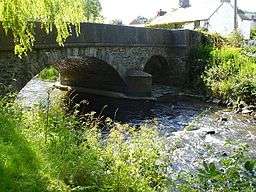 Llanfechain Bridge over Afon Cain
Llanfechain Bridge over Afon Cain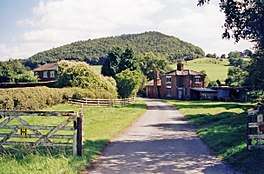 Llanfechain railway station (now a private house)
Llanfechain railway station (now a private house) North side of Llanfechain Bridge, view towards Bodynfoel
North side of Llanfechain Bridge, view towards Bodynfoel
References
- ↑ "Community population 2011". Neighbourhood Statistics. Office for National Statistics. Retrieved 13 November 2015.
- ↑ Lloyd, John Edward (1912). A History of Wales from the Earliest Times to the Edwardian Conquest. Longmans, Green, and Co. p. 247. Retrieved 16 April 2015.
- ↑ Cathrall, William (1828). The History of North Wales Volume II. Manchester. p. 345.
- ↑ Richards, Robert (1949). "Y domen Gastell". Montgomeryshire collections relating to Montgomeryshire and its borders. 51: 72. Retrieved 15 April 2015.
- 1 2 3 4 5 6 "Historic Settlement Survey - Montgomeryshire - Llanfechain" (PDF). Clwyd Powys Archaeological Trust. Retrieved 23 March 2015.
- 1 2 Baring-Gould, Sabine; Fisher, John. The Lives of the British Saints Volume 3. p. 77.
- ↑ Room, Adrian (2010). Dictionary of Pseudonyms: 13,000 Assumed Names and Their Origins, 5th ed. McFarland. p. 214.
- ↑ "Church of St Garmon , Llanfechain". Montgomeryshire Churches Survey. Retrieved 2008-05-05.
- ↑ "Church of St. Garmon, Llanfechain". British Listed Buildings. Retrieved 14 December 2013.
- 1 2 "Trail Two – The Cain Valley Trail - St Garmon, Llanfechain" (PDF). April 2009. Retrieved 23 March 2015.
- ↑ "PENUEL METHODIST CHAPEL (WESLEYAN), LLANFECHAIN". Coflein. Retrieved 26 March 2015.
- ↑ "LLANFECHAIN CHAPEL (WELSH CALVINISTIC METHODIST;SOAR), LLANFECHAIN". Coflein. Retrieved 26 March 2015.
- ↑ "The Churches of Britain and Ireland". The Churches of Britain and Ireland. Retrieved 26 March 2015.
- ↑ "Llanfechain: Church History". Genuki. Retrieved 26 March 2015.
- ↑ "Domen Gastell, Llanfechain". Retrieved 27 March 2015.
- 1 2 An Inventory of the Ancient Monuments in Wales and Monmouthshire: I - County of Montgomery. Royal Commission on the Ancient and Historical Monuments of Wales. 1913. p. 89.
- ↑ "Llanfechain". Visitor UK. Retrieved 26 March 2015.
- ↑ "Ty-coch, Llanfechain". British Listed Buildings. Retrieved 26 March 2015.
- 1 2 "Llanfechain". Visitor UK. Retrieved 14 April 2015.
- ↑ "Plas Cain, Llanfechain". British Listed Buildings.
- ↑ "Old Rectory, Llanfechain". British Listed Buildings. Retrieved 26 March 2015.
- ↑ "Bodynfoel Hall". Parks and Gardens UK. Retrieved 23 March 2015.
- ↑ "Bodynfoel Hall". British Listed Buildings. Retrieved 23 March 2015.
- ↑ "BODYNFOEL HALL, GARDEN, LLANFECHAIN". RCAHMW (Coflein). Retrieved 26 March 2015.
- ↑ Koch, John T (2006). Celtic Culture: Aberdeen breviary-celticism. ABC-CLIO. p. 862.
- ↑ Lewis, Samuel (1833). A Topographical Dictionary of Wales.
- ↑ "Walter Davies ('Gwallter Mechain') and The Board of Agriculture". The National Library of Wales. Retrieved 2008-05-05.
- ↑ Fordham, pp. 203–4.
- ↑ Chris Gostick, "Extra Material on James Hanley's The Closed Harbour". The Closed Harbour. (Richmond, Surrey: Oneworld Classics, 2009), p.213.
- ↑ "Victorian Llanfechain". Victorian Powys for Schools. Retrieved 2008-05-05.
- ↑ "Llanfechain Village Show". Retrieved 2008-05-05.
